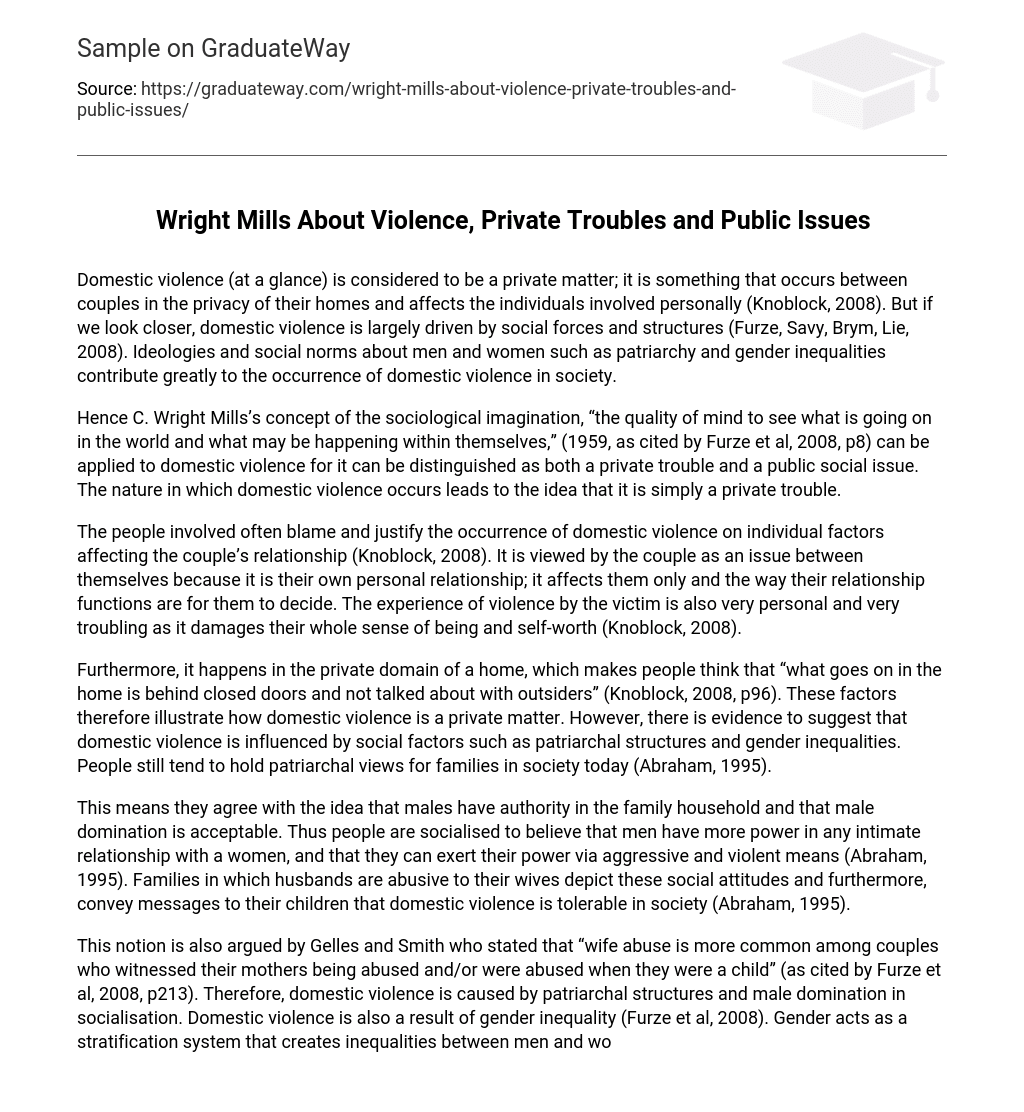Domestic violence (at a glance) is considered to be a private matter; it is something that occurs between couples in the privacy of their homes and affects the individuals involved personally (Knoblock, 2008). But if we look closer, domestic violence is largely driven by social forces and structures (Furze, Savy, Brym, Lie, 2008). Ideologies and social norms about men and women such as patriarchy and gender inequalities contribute greatly to the occurrence of domestic violence in society.
Hence C. Wright Mills’s concept of the sociological imagination, “the quality of mind to see what is going on in the world and what may be happening within themselves,” (1959, as cited by Furze et al, 2008, p8) can be applied to domestic violence for it can be distinguished as both a private trouble and a public social issue. The nature in which domestic violence occurs leads to the idea that it is simply a private trouble.
The people involved often blame and justify the occurrence of domestic violence on individual factors affecting the couple’s relationship (Knoblock, 2008). It is viewed by the couple as an issue between themselves because it is their own personal relationship; it affects them only and the way their relationship functions are for them to decide. The experience of violence by the victim is also very personal and very troubling as it damages their whole sense of being and self-worth (Knoblock, 2008).
Furthermore, it happens in the private domain of a home, which makes people think that “what goes on in the home is behind closed doors and not talked about with outsiders” (Knoblock, 2008, p96). These factors therefore illustrate how domestic violence is a private matter. However, there is evidence to suggest that domestic violence is influenced by social factors such as patriarchal structures and gender inequalities. People still tend to hold patriarchal views for families in society today (Abraham, 1995).
This means they agree with the idea that males have authority in the family household and that male domination is acceptable. Thus people are socialised to believe that men have more power in any intimate relationship with a women, and that they can exert their power via aggressive and violent means (Abraham, 1995). Families in which husbands are abusive to their wives depict these social attitudes and furthermore, convey messages to their children that domestic violence is tolerable in society (Abraham, 1995).
This notion is also argued by Gelles and Smith who stated that “wife abuse is more common among couples who witnessed their mothers being abused and/or were abused when they were a child” (as cited by Furze et al, 2008, p213). Therefore, domestic violence is caused by patriarchal structures and male domination in socialisation. Domestic violence is also a result of gender inequality (Furze et al, 2008). Gender acts as a stratification system that creates inequalities between men and women by ranking men above women within the same race and class (Lorber, 2003, as cited by Knoblock, 2008).
Because men had a higher rank, they had more power and more prestige than women. This paved way for male domination of women in society (Knoblock, 2008). Gender inequality also reinforced stereotypes about masculinity and femininity i. e. men were tough, authoritative, powerful whilst women were passive, weak and dependent (Knoblock, 2008). These ideas permeated society, and hence provided reasons for men to think that they have a right to assault a woman (Knoblock, 2008). The link between domestic violence and gender inequality is further highlighted by Straus.
In his research, he found that wife assault increases when gender inequality increases and wife assault decreases when gender inequality decreases (Furze et al, 2008). Thus, domestic violence is closely related to gender inequality, where its occurrence is based on the existence of norms, which justify male domination of women, and power imbalances between men and women (Furze et al, 2008). From this discussion, it can be concluded that domestic violence is both a private trouble and a public issue using C.
Wright Mills’ sociological imagination. References Abraham, M. (1995). Ethnicity, Gender, and Marital Violence: South Asian Women’s Organizations in the United States. Gender and Society, 9(4), 450-468. Furze, B. , Savy, P. , Brym, R. , & Lie, J. (2008). Sociology in Today’s World. South Melbourne; Cengage Learning Australia. Knoblock, J. (2008). Gender and Violence: A Reflective Sociology of How Gender Ideologies and Practices Contribute to Gender Based Violence. Human Architecture: Journal of the Sociology of Self-Knowledge, 1(2), 91-102.





